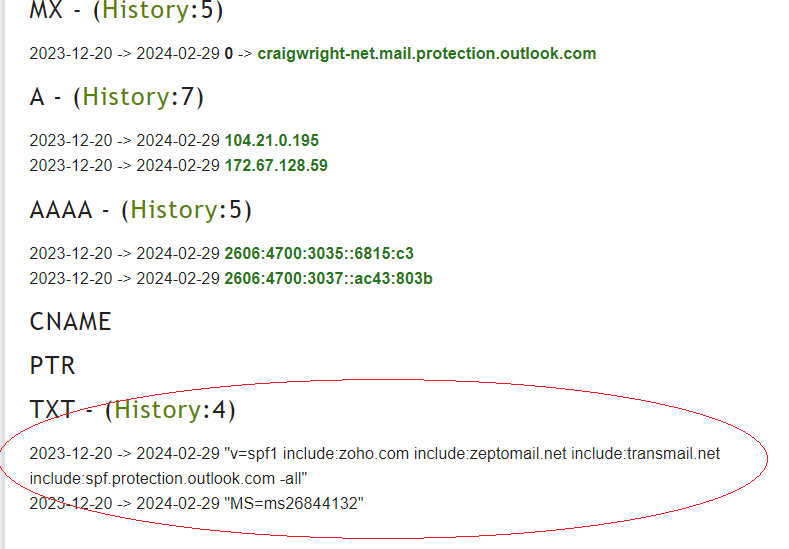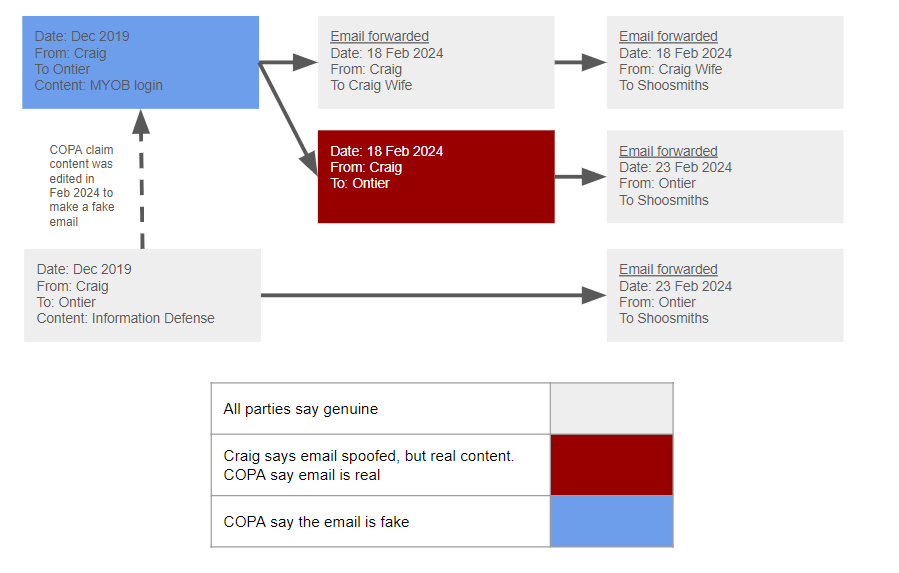 After Judge James Mellor in the U.K. rendered his decision in the notable lawsuit initiated by the Crypto Open Patent Alliance (COPA) against Craig Wright, he concluded that Wright did not embody the persona of the pseudonymous Satoshi Nakamoto. Subsequently, Mellor enforced a worldwide injunction on Wright’s holdings, freezing assets valued at £6.7 million (approximately […]
After Judge James Mellor in the U.K. rendered his decision in the notable lawsuit initiated by the Crypto Open Patent Alliance (COPA) against Craig Wright, he concluded that Wright did not embody the persona of the pseudonymous Satoshi Nakamoto. Subsequently, Mellor enforced a worldwide injunction on Wright’s holdings, freezing assets valued at £6.7 million (approximately […]
Source link
Craig
Craig Wright claims coincidence in timing of spoofed emails as DNS records altered yesterday
The highly contentious COPA vs. Wright trial took a dramatic turn today as Craig Wright faced accusations of manipulating key evidence to support his claim of being Bitcoin’s pseudonymous creator, Satoshi Nakamoto. Reporting via the court live stream, CryptoSlate tuned in to hear Wright’s testimony in what is likely to be his final appearance.
The day’s proceedings focused on emails allegedly sent between Wright and his former legal firm, Ontier LLP. These emails are pivotal in proving or debunking Wright’s longstanding assertion of Satoshi Nakamoto’s identity.
COPA, represented by Mr. Hough, argued that changes to SPF (Sender Policy Framework) records for several domains controlled by Wright suspiciously occurred on Feb. 29, 2024, the same day Wright submitted new evidence. This timing casts doubt on the legitimacy of the submitted materials.

COPA focused its attack on a December 2019 email chain between Wright and Ontier about MYOB accounting software. While acknowledging the conversation as genuine, Wright claimed missing parts of the email existed.
Crucially, Wright’s wife sent a version of this same email chain to his current lawyers in February 2024. COPA highlighted that this email contained a nChain logo with a Feb. 18, 2024 timestamp – making it chronologically impossible as the email originated in 2019. Wright disputed this, bizarrely suggesting Google manipulates email timestamps.
After initial denial, Wright was forced to concede under cross-examination that the “Ramona email” his wife sent was not genuine. This admission came only after Ontier LLP confirmed the doctored email following their investigation.
Amid wandering testimony, Bitmex Research reporters captured the following statement from Wright,
“Hough: Is it your position that the spoofer, happened to do it on the same morning that your wife sent the real version, by coincidence?
CSW: Unfortuntely, yes.”
Bitmex Research compiled a graphic in an attempt to highlight Wright’s account of the evidence. Wright proclaims that on Feb. 18, 2024, Ontier received a fake email, which he contends contained legitimate information regarding his MYOB login details. Concurrently, he also emailed his wife with identical information, which he maintains was a legitimate communication.

Wright’s Defense: Spoofing Claims and Shifting Blame
In a counter-argument, Wright claimed an almost identical but spoofed email was sent to Ontier on Feb. 24, 2024. He made vague technical arguments about email headers and malleable timestamps, insisting dates cannot be trusted.
When pressed by the judge for specifics on the spoofing allegation – asking who was responsible and their motive – Wright claimed it was a simple act. He further suggested many people could be suspects, as many had copies of his emails. The judge intervened with pointed questions seeking clarity on Wright’s accusations.
Wright spent considerable time in his witness statement discussing an email he later declared fake. This contradiction, coupled with inconsistencies regarding the nChain logo and the coincidental timing of his SPF record changes, severely undermines Wright’s credibility.
Ultimately, Wright claims that a spoofed email was sent, making it look like he had forged it to discredit his claim. Essentially, he is not denying the forged data, but rather than admitting responsibility, he alleges someone is attempting to sabotage his defense.
After lunch, the expert witness, Mr. Madden, retook the stand. He stated,
“There are no such indicators of a spoof. The layout of this header is typical to standard infrastructure.”
A core part of Wright’s defense is that he, the alleged genius creator of Bitcoin, the most secure decentralized network on earth, has been hacked numerous times by multiple parties. Due to those hacks, he has been discredited.
Satoshi Correspondence Revealed by Witnesses in Legal Clash Against Craig Wright
 In the unfolding lawsuit between the Crypto Open Patent Alliance (COPA) and Craig Wright, three key witnesses who had early interactions with Bitcoin’s creator, Satoshi Nakamoto, provided their testimonies. Among them were early Bitcoin developers Martti Malmi and Mike Hearn, as well as Adam Back, the creator of Hashcash, the proof-of-work (PoW) algorithm integral to […]
In the unfolding lawsuit between the Crypto Open Patent Alliance (COPA) and Craig Wright, three key witnesses who had early interactions with Bitcoin’s creator, Satoshi Nakamoto, provided their testimonies. Among them were early Bitcoin developers Martti Malmi and Mike Hearn, as well as Adam Back, the creator of Hashcash, the proof-of-work (PoW) algorithm integral to […]
Source link
UK Law Commission report challenges Craig Wright’s suit against Bitcoin developers

A recent report released by the United Kingdom’s Law Commission could weaken a central argument brought by Craig Wright in his controversial lawsuit against 12 Bitcoin Core developers, argues the Bitcoin Legal Defense Fund (BLDF).
In a 300-page report on digital assets published in late June, the Law Commission — an independent body that reviews and recommends reforms to U.K. and Whales laws — cited a classification of fiduciary duty that bolsters the developers’ defense that they are not directly responsible for 111,000 Bitcoin (BTC) lost to hackers.
Wright, owner of Tulip Trading, claimed in a 2021 lawsuit that developers involved in the open-source development of Bitcoin Core owed him a fiduciary duty in connection with his loss. In order to recover the allegedly stolen funds, Wright is seeking a back door into the Bitcoin blockchain. Wright is also known for claiming he is Bitcoin’s pseudonymous creator Satoshi Nakamoto.
The bitcoin protocol was set in stone to create a system that is stable. Bitcoin is not a Cryptocurrency. By definition, Cryptocurrencies are anonymous and untraceable. Bitcoin is pseudonymous and traceable, it is digital cash.
Don’t believe everything you see at first sight. pic.twitter.com/vPt4a0fEEx
— Dr Craig S Wright (@Dr_CSWright) May 30, 2023
The U.K. report sheds light on the definition of fiduciary duty, claiming that categories of fiduciary recognized by the law include “agents, trustees, partners, company directors, and solicitors.” The report said fiduciary duty rarely exists outside these categories. According to the BLDF, the developers’ legal representative, the defendants do not fit any criteria mentioned by the Commission.
“They are not agents, trustees, partners, company directors, or solicitors, and they never ‘undertook or were entrusted with authority to manage the property or make discretionary decisions on behalf of another person,’” BLDF stated in a recent blog post, adding that “Bitcoin was created to facilitate transactions between individuals without the need to entrust any authority to a third party.”
According to a definition by the University of Texas, fiduciary duty is the “legal responsibility to act solely in the best interest of another party.” Common examples of fiduciary duties include undivided loyalty, due diligence, full disclosure of conflicts of interest and confidentiality.
The Tulip Trading suit could set case law for open-source developers’ liability for assets, with a trial in the case expected to occur in 2024. During the Bitcoin 2023 conference in May, Jessica Jonas, BLDF’s chief legal officer, noted that potential legal ramifications of the lawsuit could deeply affect the community of open-source developers, as 97% of the world’s software programs are open-sourced.
The U.K. Law Commission report also pushed for the creation of a new and distinct category of personal property to accommodate the unique features of digital assets.
Magazine: $3.4B of Bitcoin in a popcorn tin — The Silk Road hacker’s story




